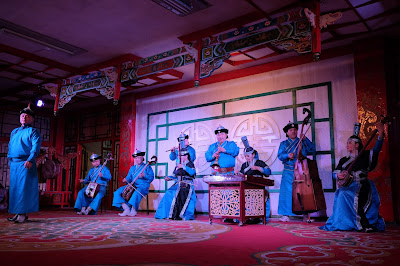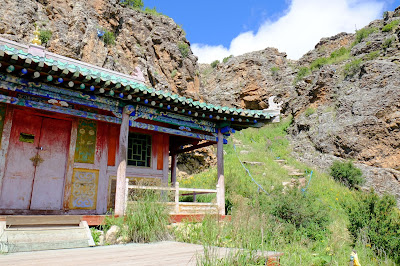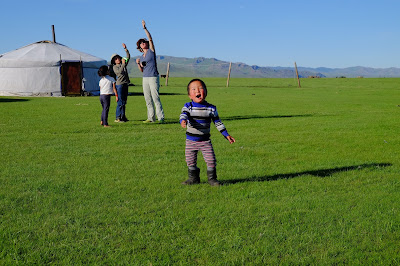Day 1 of our tour with Horseback Mongolia started by meeting our group at a hotel just off of Chinggis Square. Our group consisted of 9 people--the four of us, Caroline and Olivier (from France), Vipasha (from Australia), and Arthur and Maria (Polish living in the UK). Our Mongolian guide for the tour, Boogie, welcomed us all during lunch.
Then we headed to the National Museum of Mongolia, which has 9 halls dedicated to history and culture--from pre-historic times to the democracy movement of the 1990s. Some of the most interesting exhibits were the contents of burial mounds and traditional costumes from all of Mongolia's 20+ ethnic groups.
After the museum, we did some quick shopping for supplies and then headed to see Tumen Ekh, the Mongolian national song and dance ensemble. We really enjoyed their performance of folk music and dancing, khoomi (traditional throat singing that was so unique), contortionists, and a ceremonial Buddhist mask dance.
After dinner, the boys were very happy to relax in hotel bathrobes....we thought they looked pretty cute.
The next day (Day 2), we loaded all our things into 2 Russian-style vans and met the rest of the tour staff-- Mendee and Nyam (our drivers) and Oyunaa (our cook). Our first stop was Gandan Monastery, which is well known because of its 26 meter (85 feet) tall standing Buddhist statue.
We then left UB heading west.....it was exciting to see the big city fade away and the open countryside start to appear! Along the way, Boogie noticed people gathered in a field, so we pulled off the road to find a horse festival going on. We were invited to sit in the seats reserved for guests of honor, and we were served our first (of many) serving of airag--mare's fermented milk that is slightly alcoholic (about 3%) and quite pungent. It is definitely an acquired taste that none of us acquired on this tour. This is Emmett trying his first sip, before he knew any better.
It was neat to see children riding around--Mongolian children usually learn to ride not long after they learn to walk, so these kids were completely at ease.
From there we headed to Khongo Khan National Park, where we'd spend the night in tee pees.
After dinner, we took our first horseback in the open steppe with incredible rock formations all around.
Rainy Day 3 began with a visit to Erdene Khamblin monastery, which was built in the 17th century. Like many monasteries in Mongolia, Erdene Khamblin was destroyed in the 1930s as part of Stalin's purges. We could see the remains of the original monastery and we were also able to visit a rebuilt temple. The caretaker was a woman whose great-grandfather had been a monk there in the '30s. When the monastery was destroyed, most monks were also killed. However, he was spared because he was elderly and did not pose a threat to Stalin's vehemently anti-religious plans.
We drove on to Erdene Zuu, the oldest monastery in Mongolia (built in the 1500s). We toured the Chinese-styled buildings and saw lots of Buddhist art and artifacts.
Next we stopped briefly by two important rocks--Turtle Stone and Penis Stone (yes, you read that correctly). Each is important in Mongolia for different reasons--I'll let the signs explain how.
We then left the smooth, paved road and headed off along what would be the first of many, many bumpy, dirt roads. The boys loved bouncing around....because, of course, Russian-style vans don't have seat belts (note: adventurous travel does not always involve US-style safety...).
With all the rain, we drove through a lot of water and mud as we arrived in the Orkhon Valley.
The lush green fields and hills were just beautiful.
Just before we arrived at our camp, we encountered a slight "challenge": a wooden bridge that we were supposed to cross had been damaged and was unusable.
No problem for Mendee and Nyam--they simply opened the engine hatch (located inside the van) to adjust the air intake so that we could drive through the river!
Nyam actually got splashed by river water inside the car as he drove. While the boys thought it was AMAZING to go through such high water, I was glad to get to land on the other side without floating downstream.
Day 4 thankfully included far less rain--we woke up to beautiful blue skies and fantastic scenery, including yaks!
We quickly were immersed in the family's daily life, which included a lot of things that were new and/or a bit different for us. We watched the family's dog eating from the head of a goat that had been recently slaughtered.
We saw different animal parts drying in the sun.
We tried milking yaks with the wife of the family.
The Moorhouse dudes herded yaks--I'm pretty sure if you listened closely, you could hear the soundtrack from "City Slickers" playing in the countryside of Mongolia.
While there, we helped a family put up a new ger. First the husband and wife were sewing large pieces of felt together to create what will become the ger cover.
It was really cool to see how the ger goes from piles of wood poles and felt to a cozy shelter. This beautifully decorated circle piece becomes the middle of the roof.
First the men attached the very important center poles to the circular piece. This gets set up in what will be the middle of the ger.
Then a latticework circular frame is set up.
Then wooden poles are inserted into the circular roof piece and rested on the latticework frame. The boys were really excited to help with this part.
Once the roof is constructed, heavy felt is laid on top of the wooden poles. More felt goes around the latticework eventually, too.
When we got back to camp, Colin decided to go for a brief swim in the frigid stream.
What was left after this process was then put into a burlap bag to make cheese, which has by that point been twice boiled and once fermented. The nomadic families are incredibly adept at wasting nothing and turning the milk from their yaks/goats/sheep/horses into multiple different products.
The vast open steppe was amazing.
The monastery was about 1.5 km up a hill, which took me about an hour to hike with the group. Bob and the boys rode horses up and back down, and the boys were excited because the horses went fast and, as Colin explained, "I almost fell off".
On our way back from the monastery, we stopped to watch a mare being milked...more airag in the making (oh goody).
We even stopped by the neighborhood corner ger for snacks and drinks.
We got back and enjoyed our first "Mongolian Happy Hour" with the group.
The boys played with the family's kids.....their favorite thing, by far, was our kite. The smallest boy chased back and forth after it.
Boogie and the group surprised Bob and I with applause, beer, and a present in honor of our 14th wedding anniversary--a game consisting of goat bones and a string. Two small bones must be moved from two separate loops onto one loop. Traditionally, this game was given to a woman before her wedding. If she could move the small bones from two loops to one, she would make a good wife. The wife of the family tried to show me how it's done, but I was completely lost--apparently I would not make a good Mongolian wife.
The family slaughtered a goat in honor of our last night. They cooked it for us in a traditional way, putting hot stones inside the container to cook the meat from inside as well as from the outside (over the stove).
After we ate, the boys threw the goat bones into the air for the waiting birds to catch. It was fun to watch them swoop down to catch the bones in mid-air.
We ended our stay with a small bonfire and stargazing....since there are few lights, we could see countless stars and quite a few shooting ones. It was a perfect ending to our first family stay and our time in Orkhon Valley.
Want to read more about our tour in the Mongolian countryside? Here's Part 2 and Part 3.
Want to read more about our tour in the Mongolian countryside? Here's Part 2 and Part 3.







































































Love your entries!! -Kari Jones
ReplyDeletethanks for sharing nice post
ReplyDeleteMongolia Buddhist Monasteries tour